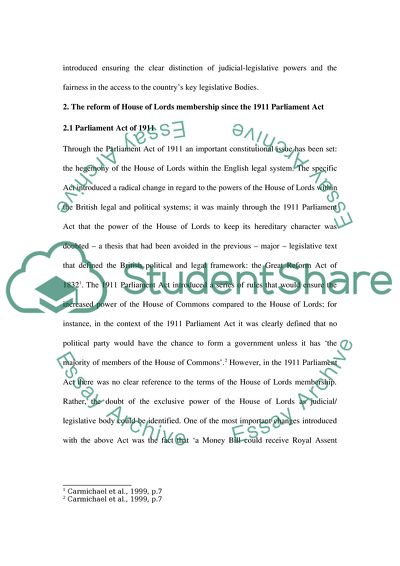Cite this document
(Public Law and Civil Rights Term Paper Example | Topics and Well Written Essays - 2500 words, n.d.)
Public Law and Civil Rights Term Paper Example | Topics and Well Written Essays - 2500 words. Retrieved from https://studentshare.org/law/1743638-public-law-and-civil-rights-discuss-the-extent-to-which-reform-of-house-of-lords-membership-has-been-achieved-in-the-century-since-the-parliament-act-and-is-likely-to-be-further-achieved-in-the-near-future
Public Law and Civil Rights Term Paper Example | Topics and Well Written Essays - 2500 words. Retrieved from https://studentshare.org/law/1743638-public-law-and-civil-rights-discuss-the-extent-to-which-reform-of-house-of-lords-membership-has-been-achieved-in-the-century-since-the-parliament-act-and-is-likely-to-be-further-achieved-in-the-near-future
(Public Law and Civil Rights Term Paper Example | Topics and Well Written Essays - 2500 Words)
Public Law and Civil Rights Term Paper Example | Topics and Well Written Essays - 2500 Words. https://studentshare.org/law/1743638-public-law-and-civil-rights-discuss-the-extent-to-which-reform-of-house-of-lords-membership-has-been-achieved-in-the-century-since-the-parliament-act-and-is-likely-to-be-further-achieved-in-the-near-future.
Public Law and Civil Rights Term Paper Example | Topics and Well Written Essays - 2500 Words. https://studentshare.org/law/1743638-public-law-and-civil-rights-discuss-the-extent-to-which-reform-of-house-of-lords-membership-has-been-achieved-in-the-century-since-the-parliament-act-and-is-likely-to-be-further-achieved-in-the-near-future.
“Public Law and Civil Rights Term Paper Example | Topics and Well Written Essays - 2500 Words”, n.d. https://studentshare.org/law/1743638-public-law-and-civil-rights-discuss-the-extent-to-which-reform-of-house-of-lords-membership-has-been-achieved-in-the-century-since-the-parliament-act-and-is-likely-to-be-further-achieved-in-the-near-future.


